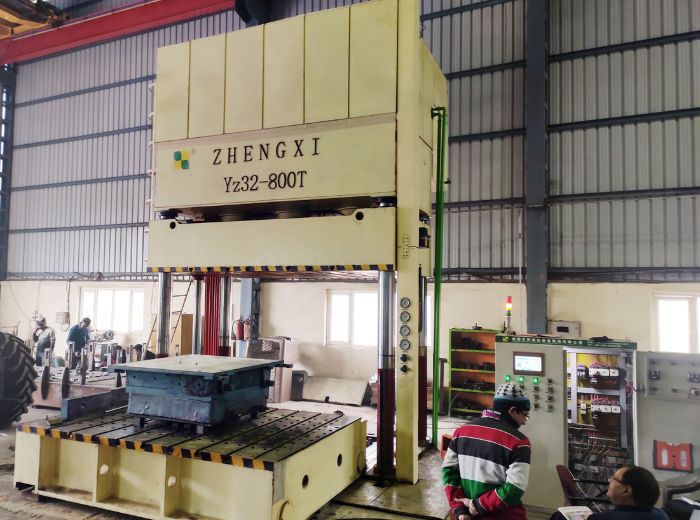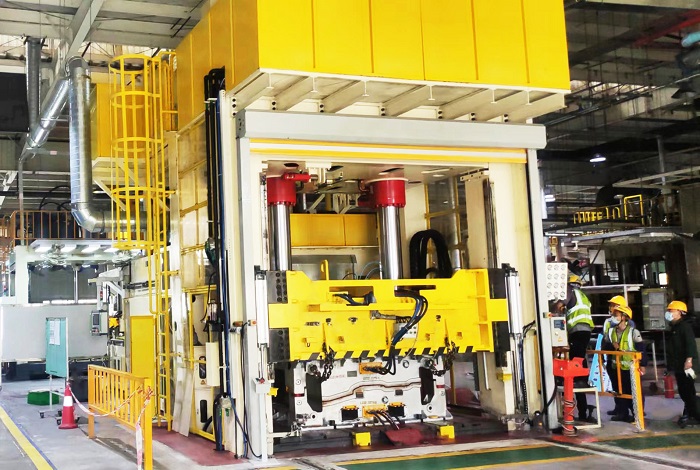Hydraulic presses are versatile machines widely used in industries for shaping, forming, and assembling various materials. While the basic function of a hydraulic press remains the same—using hydraulic pressure to generate force—there are different types of hydraulic presses available, each with its advantages. Among these, servo-hydraulic presses and ordinary hydraulic presses are two prominent categories. While they share some commonalities, they differ significantly in operation, efficiency, precision, and control. This blog will delve into the key differences between servo-hydraulic presses and ordinary hydraulic presses, helping you understand which type might best fit your specific needs.
1. Operation and Control Systems
A hydraulic press’s operation and control systems play a crucial role in determining its efficiency, precision, and ease of use.
Servo-Hydraulic Presses: Servo-hydraulic presses have a servo motor that drives the hydraulic pump, offering precise control over the press’s force, speed, and position. The servo motor allows for real-time adjustments, providing exceptional control over the pressing process. The ability to finely tune the force and speed of the press during the operation ensures that the press can adapt to varying material properties and production requirements. This makes servo-hydraulic presses ideal for applications that require high precision, such as automotive part production, aerospace components, and high-quality metal forming.
Ordinary Hydraulic Presses: Ordinary hydraulic presses, in contrast, typically use a fixed-speed motor that drives the hydraulic pump. This results in a more straightforward operation but less flexibility and control than servo-hydraulic presses. The press operates at a constant speed and pressure, which may not be optimal for all applications, particularly those requiring delicate or precise control. While ordinary hydraulic presses are still effective in many applications, they may not offer the same level of adaptability as servo-hydraulic presses.
2. Precision and Accuracy
Precision and accuracy are critical in many manufacturing processes, especially in industries where slight deviations can lead to significant issues.
Servo-Hydraulic Presses: Servo-hydraulic presses are renowned for their high precision and accuracy. The servo motor’s ability to make real-time adjustments allows precise control over the pressing process. This level of control is particularly beneficial in applications where maintaining tight tolerances is crucial. The ability to program and repeat exact movements ensures consistent, high-quality output, making servo-hydraulic presses ideal for industries like electronics, medical devices, and precision metal forming.
Ordinary Hydraulic Presses: While ordinary hydraulic presses can still achieve good levels of precision, they generally cannot match the accuracy of servo-hydraulic presses. Their constant speed and pressure mean that they are less capable of handling variations in material properties or process requirements. This can lead to less consistent results, particularly in high-volume production or when working with materials that require careful handling.
3. Energy Efficiency
Energy consumption is an important consideration in manufacturing, as it directly impacts operational costs and sustainability.
Servo-Hydraulic Presses: One significant advantage of servo-hydraulic presses is their energy efficiency. The servo motor only uses energy when actively driving the hydraulic pump, significantly reducing energy consumption during idle times or low-load conditions. Additionally, the ability to control the motor speed according to the operation’s specific requirements further optimizes energy use. This efficiency can lead to substantial cost savings over time, particularly in high-volume production environments.
Ordinary Hydraulic Presses: Ordinary hydraulic presses consume more energy because the fixed-speed motor runs continuously, regardless of the load or operational demands. This constant operation can lead to wasted energy, especially during idle periods or when the press is not fully loaded. While ordinary hydraulic presses are generally less expensive upfront, their higher energy consumption can result in higher operational costs over the long term.
4. Speed and Cycle Time
A press’s speed and cycle time are critical factors in determining production efficiency, particularly in high-volume manufacturing.
Servo-Hydraulic Presses: Servo-hydraulic presses typically offer faster cycle times due to the precise control of the servo motor. The ability to quickly ramp up to the required speed and adjust the force during the operation means that the press can complete cycles more quickly without sacrificing quality. This is particularly advantageous in applications where reducing cycle time can increase productivity and throughput.
Ordinary Hydraulic Presses: Ordinary hydraulic presses usually have slower cycles than servo-hydraulic presses. The fixed-speed motor does not allow for the same rapid acceleration and deceleration level, resulting in longer cycle times. While this may be acceptable in low-volume or less time-sensitive applications, it can be a limitation in high-volume production environments where efficiency is critical.
5. Flexibility and Application Range
The range of applications a press can handle is often determined by its flexibility and adaptability.
Servo-Hydraulic Presses: Servo-hydraulic presses are highly versatile due to their programmable control systems and the ability to make real-time adjustments. This flexibility allows them to handle various materials and processes, from simple stamping to complex forming and precision assembly. The ability to fine-tune the press’s parameters for different applications makes it a valuable tool in industries where product diversity and customization are important.
Ordinary Hydraulic Presses: Ordinary hydraulic presses are generally less flexible due to their simpler control systems and fixed-speed operation. While effective in many standard pressing applications, they may struggle with more complex or varied tasks. For industries that require frequent changes in product type or material, an ordinary hydraulic press may require more manual adjustments and setup time, reducing overall efficiency.
6. Cost and Investment
The initial cost and long-term investment in a hydraulic press are important factors, particularly when deciding between a servo-hydraulic press and an ordinary one.
Servo-hydraulic Presses: Due to the advanced technology and control systems they incorporate, servo-hydraulic presses generally have a higher upfront cost. However, the increased efficiency, precision, and energy savings can lead to a higher return on investment (ROI) over time. For businesses that prioritize quality, efficiency, and long-term savings, the investment in a servo-hydraulic press is often justified.
Ordinary Hydraulic Presses: Ordinary hydraulic presses are typically more affordable upfront, making them a cost-effective option for smaller operations or those with less demanding production requirements. However, higher operational costs over time, particularly in energy consumption and maintenance, may offset the lower initial cost. For businesses with more straightforward pressing needs, an ordinary hydraulic press can be a practical and economical choice.
Conclusion
Both servo-hydraulic and ordinary hydraulic presses have their strengths and are suited to different applications. Servo-hydraulic presses offer advanced control, precision, energy efficiency, and speed, making them ideal for industries that require high-quality output and flexibility. On the other hand, ordinary hydraulic presses provide a more straightforward, cost-effective solution for less demanding applications where precision and speed are not as critical. Understanding the key differences between these two types of presses will help you choose the right machine for your specific needs, ensuring optimal performance and value in your manufacturing processes.
Post time: Aug-15-2024










